COP27 ended on the morning of November 20, one day and two nights later than expected. Most of the participants had already left the venue when the final gavel went down. Given the immensity and complexity of climate negotiations, experts will need several days, if not week, to fully decipher its outcome. If the results of the COPs are widely commented on, less is heard about their scenography. However, it says a lot about the state of the climate problem and how it is dealt with.
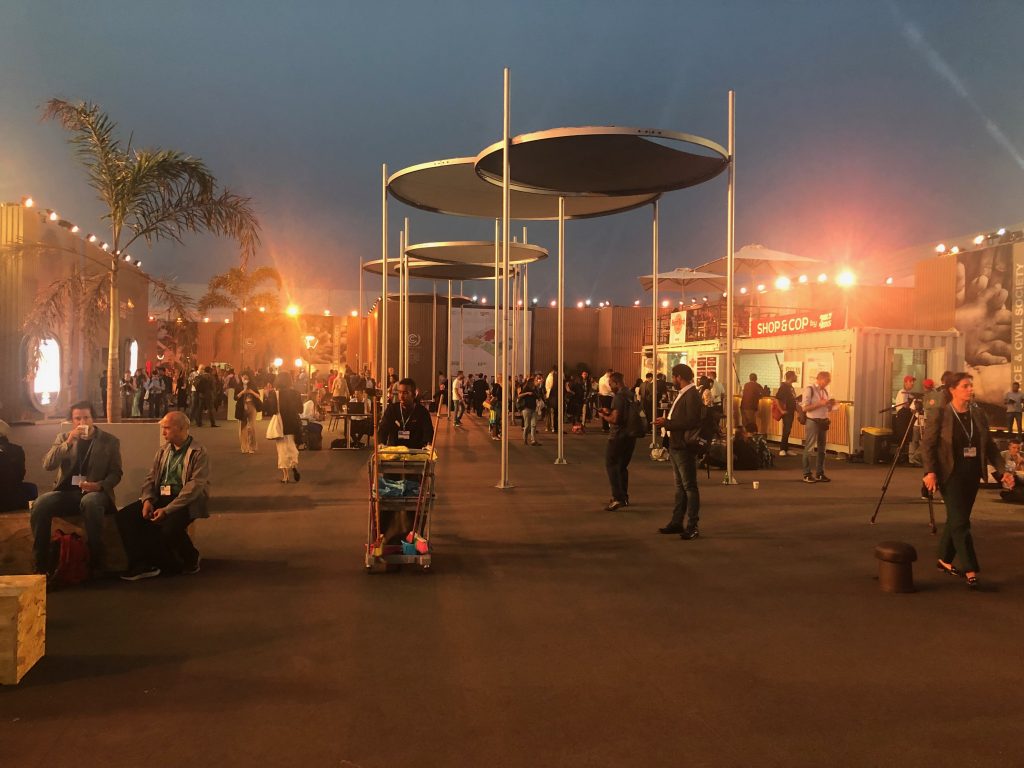
The Theatre of Negotiations
In May 2015, under the impetus of Bruno Latour and Frédérique Aït-Touati, the Parisian Théâtre des Amandiers and Sciences Po organized “Le Théâtre des Négociations”, a “pre-enactment” of COP21 that was to take place six months later in Paris. The theatricalization aimed to highlight the tragic “problems of representation” of climate conferences, and to experiment with “displacements and reformulations” in their performance. But the term “Theater of Negotiations” can also be taken literally: climate negotiations themselves are a theater. Stefan Aykut, Felix Schenuit, Jan Klenke and Emilie d’Amico have suggested that COPs can be analyzed as performances, with their own dramaturgy, scripts and distributions. During these performances, the actors mobilize distinct repertoires depending on whether they are in the negotiation, exhibition or demonstration spaces assembled in the conference sites. [1] Since the Paris COP in 2015, the number of participants and topics represented has greatly increased. This inflation is itself an instrument of the “soft coordination” that has characterized climate action since the Paris Agreement: no longer confined to negotiations between states on where to place commas and which verb to use, global climate action now involves the private sector, cities and regions as well as NGOs, under the aegis of the UNFCCC [2] Secretariat, which is taking on a more proactive coordination role. COPs increasingly feel like great climate fairs, and only a fraction of the 35,000 or so people who came to Sharm El-Sheikh were there to negotiate. Indeed, the negotiation room were not even at the center of the site, and it took a good ten minute-walk from site’s entrance to reach the plenary rooms.
In climate maze
The COPs are not always held in high places of climate action, and the arrival in Sharm El-Sheikh produces a certain dissonance. A sort of “Las Vegas without the people”, to quote a participant we met during the conference, the city stretches along an eight-lane highway lined with casinos, shopping malls and luxury resorts. In anticipation of the COP, it has been adorned with biking paths and benches on the sidewalks, apparently brand new. The COP is held in the Tonino Lamborghini Convention Centre, complemented by immense hangars and tents set up directly on roads closed to traffic.
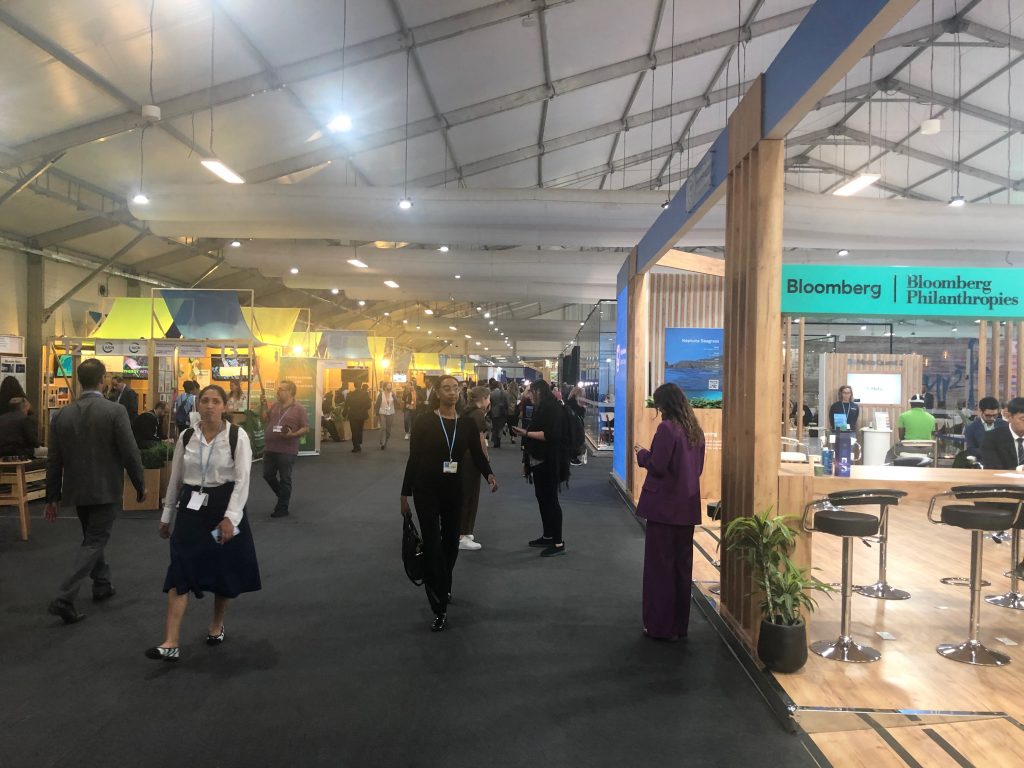
At the entrance, as at every COP, we are greeted by the followers of the Supreme Master Ching Hai; dressed as chickens and cows, they preach the benefits of veganism. Once past security, we pass under UN jurisdiction. We enter a central square surrounded by conference named after mythological Egyptian figures. A site map occupies an entire wall, and regularly serves as the background for demonstrations authorized by the UN. It will be of little help.
To leave this central square and reach the delegations’ offices and the negotiation areas, you have to cross a maze of pavilions – the exhibition areas not only for countries, but also for international institutions, NGOs or business coalitions.
As the days go by, you end up drawing a fragmented and fragile cartography, the thread of which is quickly lost when you realise the landmarks are all alike. Egypt stands at the heart of the labyrinth. The IPCC is next to Niger, and near Japan. You take a right turn at the World Bank to find the European Union, which faces Saudi Arabia. Australia (which serves good coffee) is next to the Coalition for Rainforest Nations; Italy (which also serves good coffee, but not at all hours) is near the WHO. The Mediterranean is in a corner next to the toilets – and there are also toilets between India and South Korea. The Turkey and Ukraine pavilions would be worth a second visit, but where are they?
In the four (or five? I haven’t managed to settle the count) hangars, the echoes of the micro-conferences organized in the pavilions melt into the roar of the air conditioning. It is almost impossible to know if you’ve seen everything, how long it will take you to reach a particular pavilion, or if you’re moving forward or going in circles. If you manage find the right exit, you will eventually reach the negotiation areas. They are quieter: here the labyrinth lies in the texts. [3]
Scenographies
The disorientation is not, or not only, an effect of a patchy signage. The space is saturated with messages, more or less articulated, more or less harmonious. There are maps, arrows, badges, kakemonos of numbers, posters presenting or correcting the programs of the side-events, screens showing looped videos, QR codes in every corner. Giant banners deploy watchwords – biodiversity, finance, gender, science, implementation – with a great deal of insipid images. Outside, giant screens articulate anxiogenesis and mobilizing impetus, while sporadic demonstrations, in their dedicated spaces, try to call the negotiators to order.
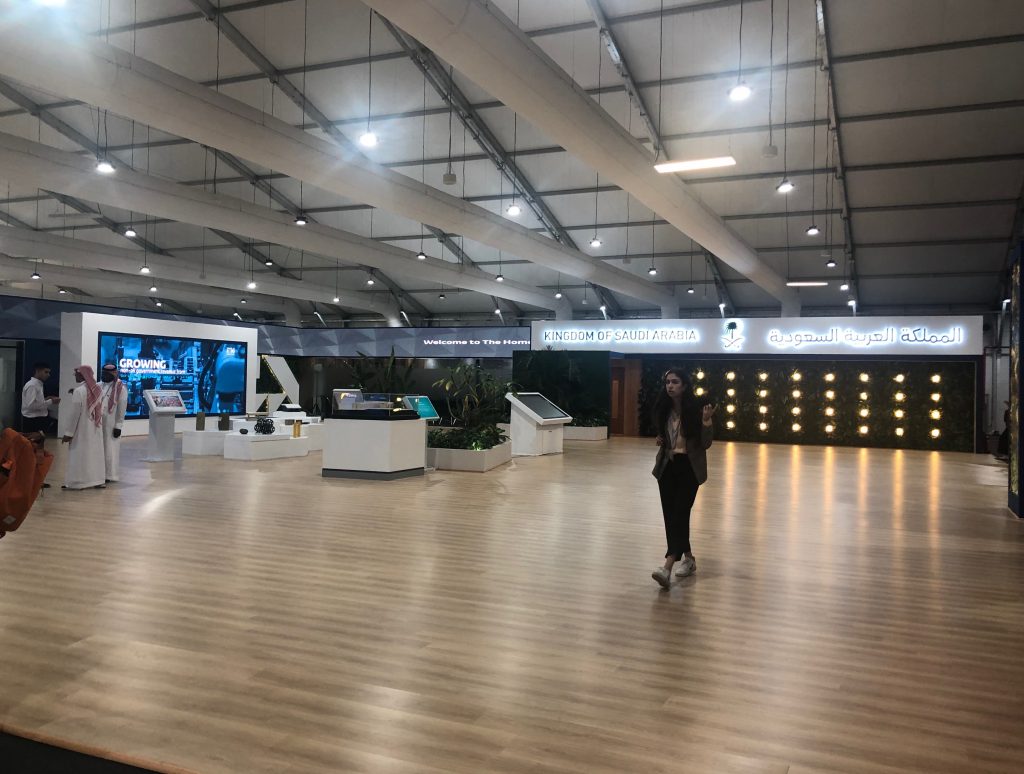
Nowhere is the deluge of signs denser, or more discordant, than in the pavilion halls. The messages are articulated as much in what is displayed – slogans, videos, infographics – or said during the events as in the material arrangement of the spaces.
The most striking example is undoubtedly the Saudi Arabia pavilion: immense and empty, its only purpose seems to be to occupy the space, summarizing quite well the negotiation strategy of the country. It stands in stark contrast to the European Union pavilion facing it: there, a cozy amphitheater has been built out of recycled vegetable pallets, and as a sign of welcome, displays a huge colorful “ACT NOW!”. Similar aesthetics can be found in several European countries’ pavilions, such as those of France, Germany or Denmark: a simple design, raw materials – wood, cardboard, cotton, no frills. The French pavilion is the same as it was at the previous COP. The Benelux pavilion, shared with the European Investment Bank, looks like a bank counter. The Ukraine pavilion is halfway between a propaganda device and an art installation: 500 cubes containing samples of Ukrainian soil, a section of tree trunk riddled with shrapnel, but also a model of wind turbines and solar panels signaling the country’s commitment to the development of renewable energy. Other pavilions feature immersive installations, such as that of Brazil, where screens show numbers, keywords and abstract patterns dancing to the rhythm of the visitors’ movements. Qatar, which came with models of all its new stadiums, does not seem to know whether it is at the COP or the Cup. The “Civil Society” pavilion, like the NGO booths for climate justice, stands almost caricaturally out of line with an overall aesthetic that oscillates between a world fair and a trade show. Pakistan – which chaired this year’s G77 negotiating group – is showing videos of flooding under the slogan “What goes on in Pakistan will not stay in Pakistan”, a reminder that this is not just another trade show. There are also representatives of non-humans: the cryosphere, the ocean, the atoms, the rainforests and even the metaverse have their own pavilions, presenting them as indispensable solutions or as threatened entities, and sometimes both at once.
Click on the images below for a larger view.
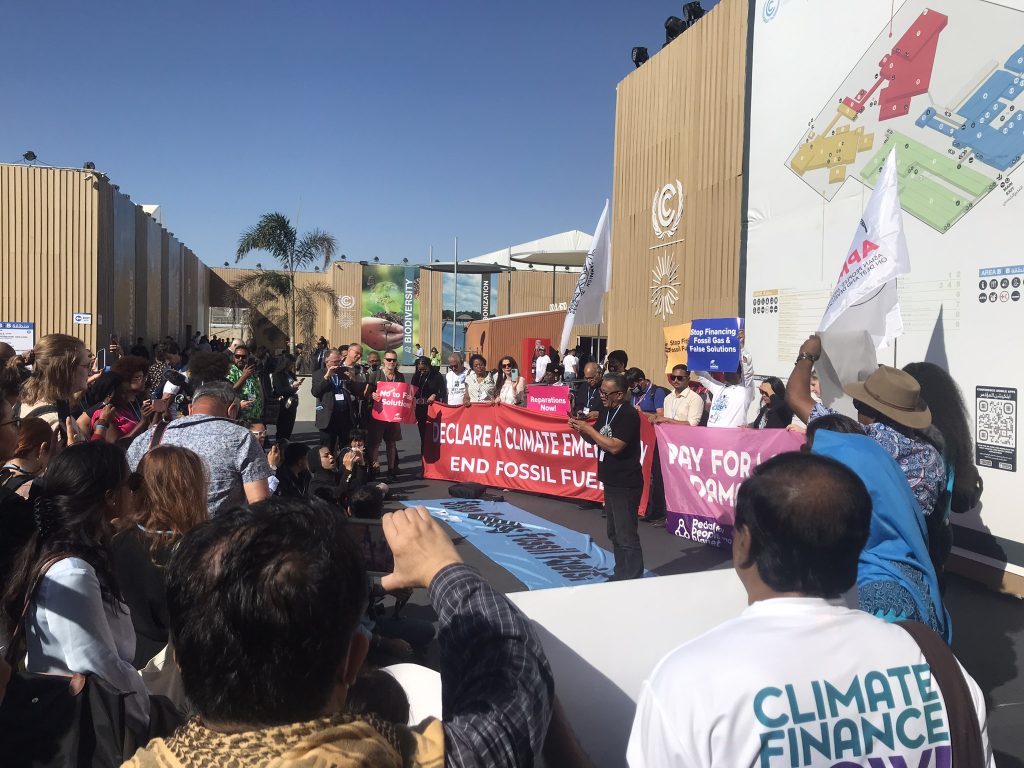
Photo credit: T. Schlesinger. CC-BY-NC-SA
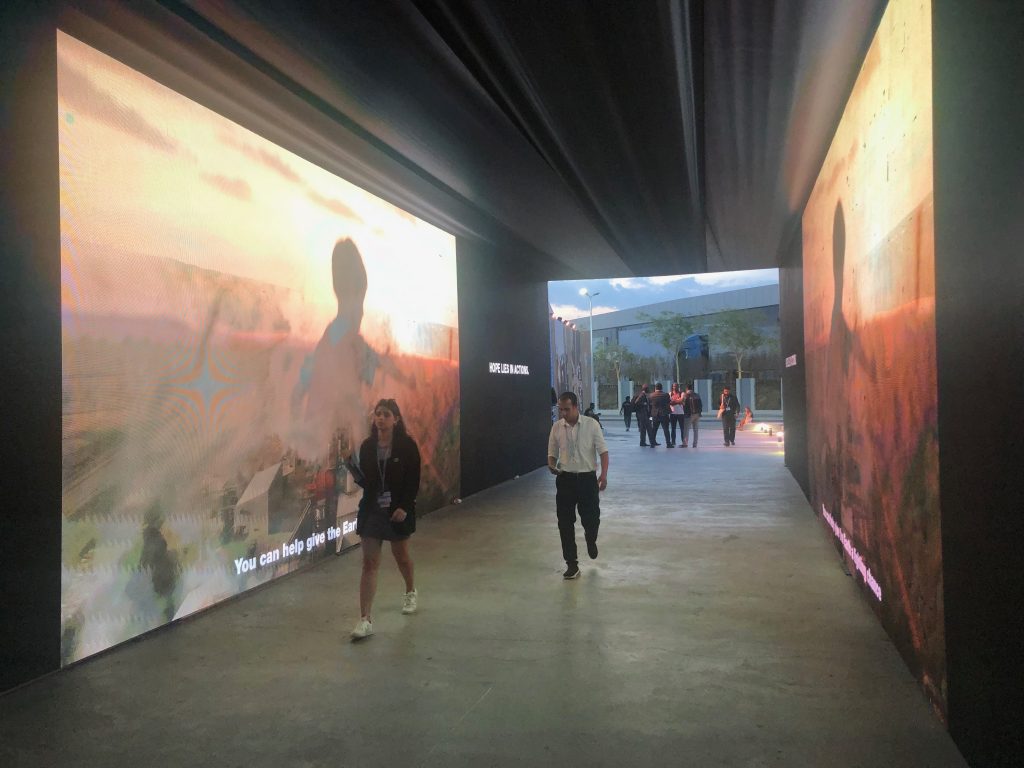
leading from the exhibition halls to the negotiation spaces.
Photo credit: B. Cointe. CC-BY-NC-SA
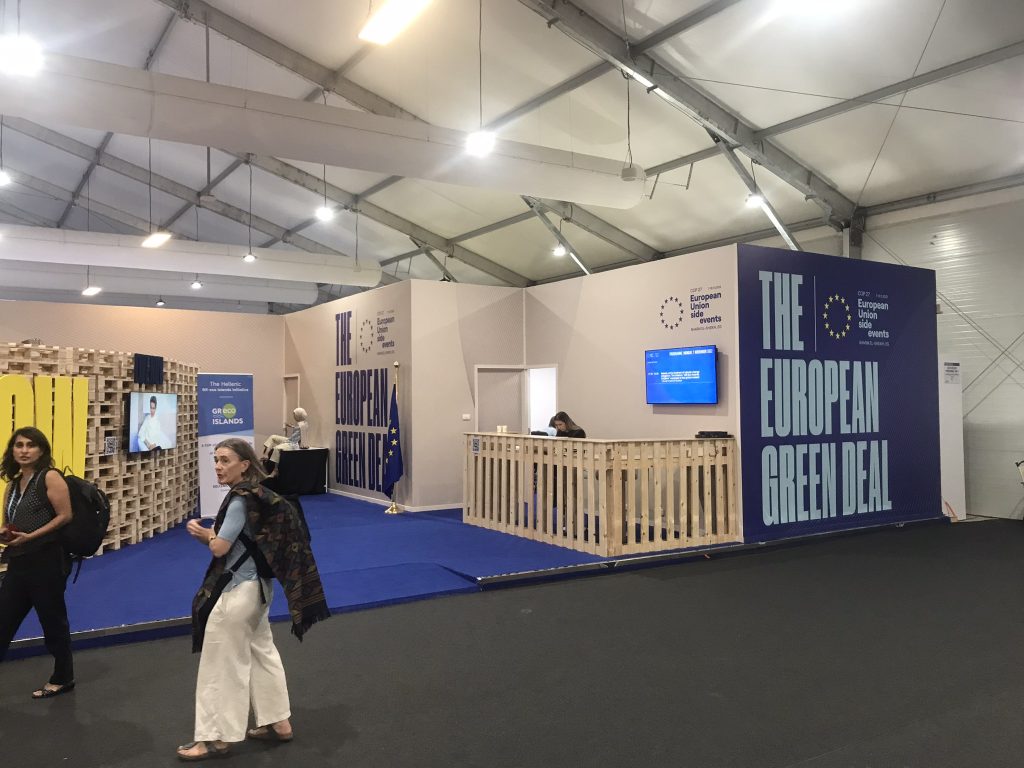
Photo credit: T. Schlesinger. CC-BY-NC-SA
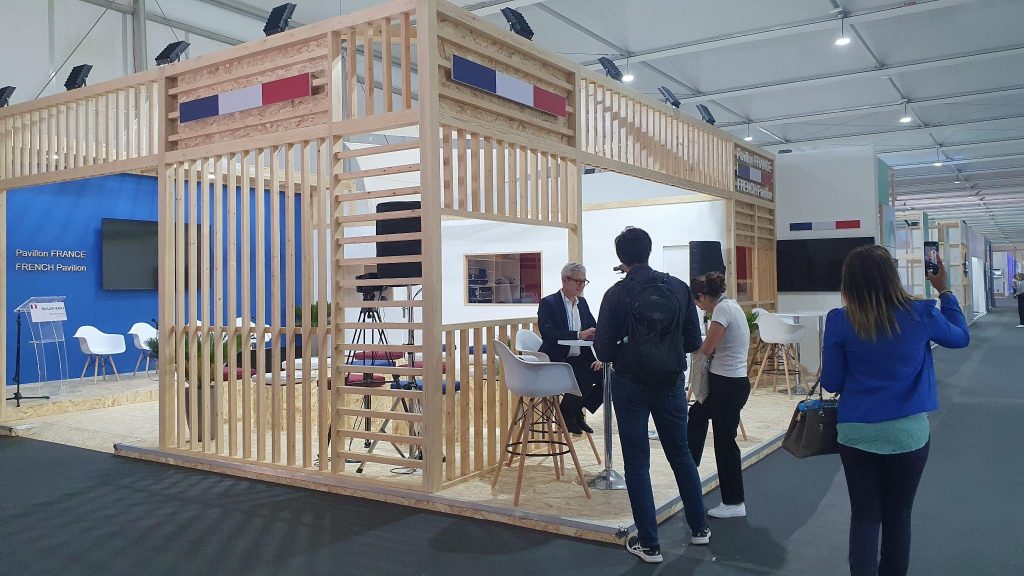
Photo credit: A. Fauste-Gay. CC-BY-NC-SA

Photo credit: B. Cointe. CC-BY-NC-SA

Photo credit: B. Cointe. CC-BY-NC-SA
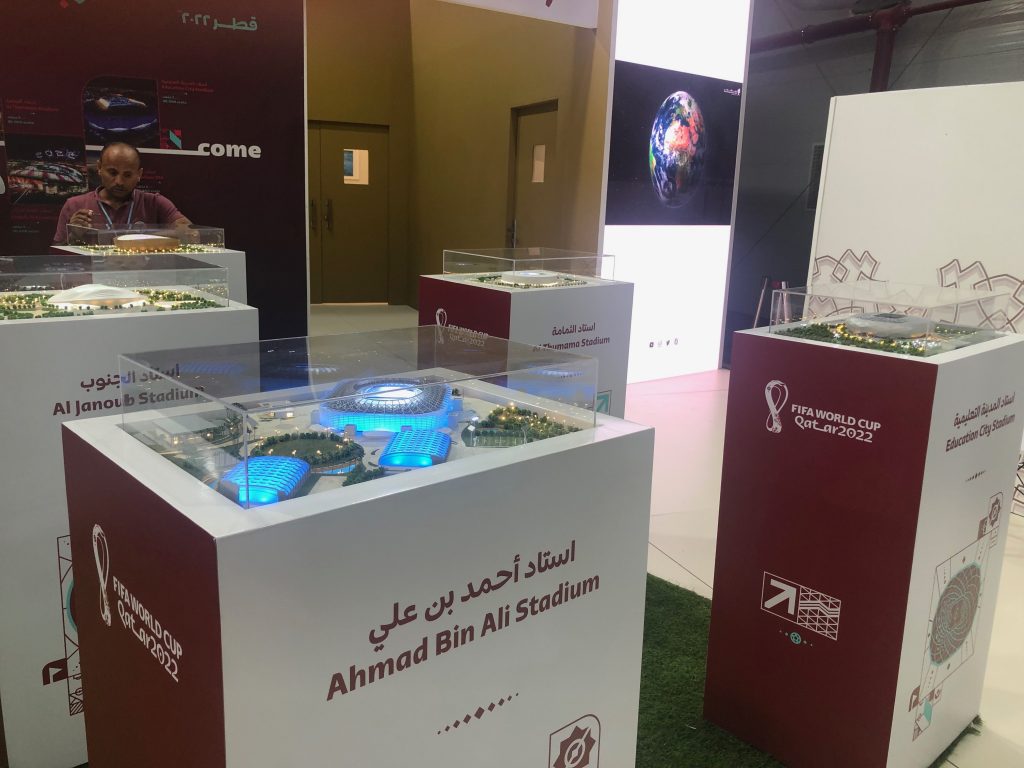
The “World Cup” section of the Qatari pavilion.
Photo credit: B. Cointe. CC-BY-NC-SA
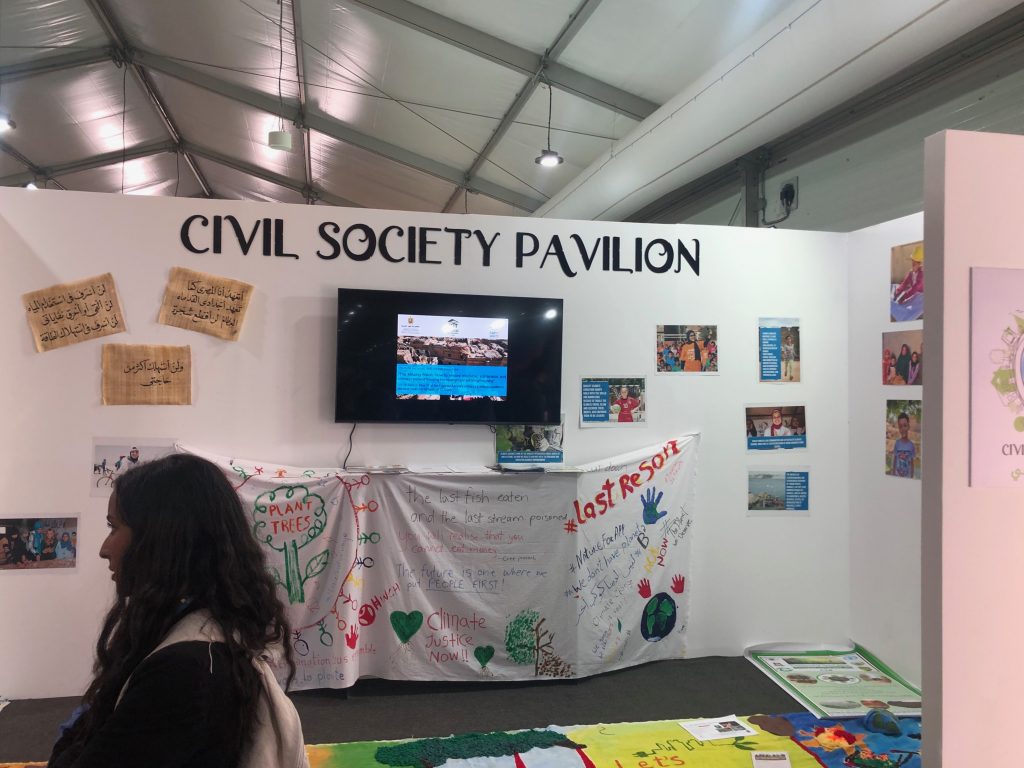
Photo credit: B. Cointe. CC-BY-NC-SA
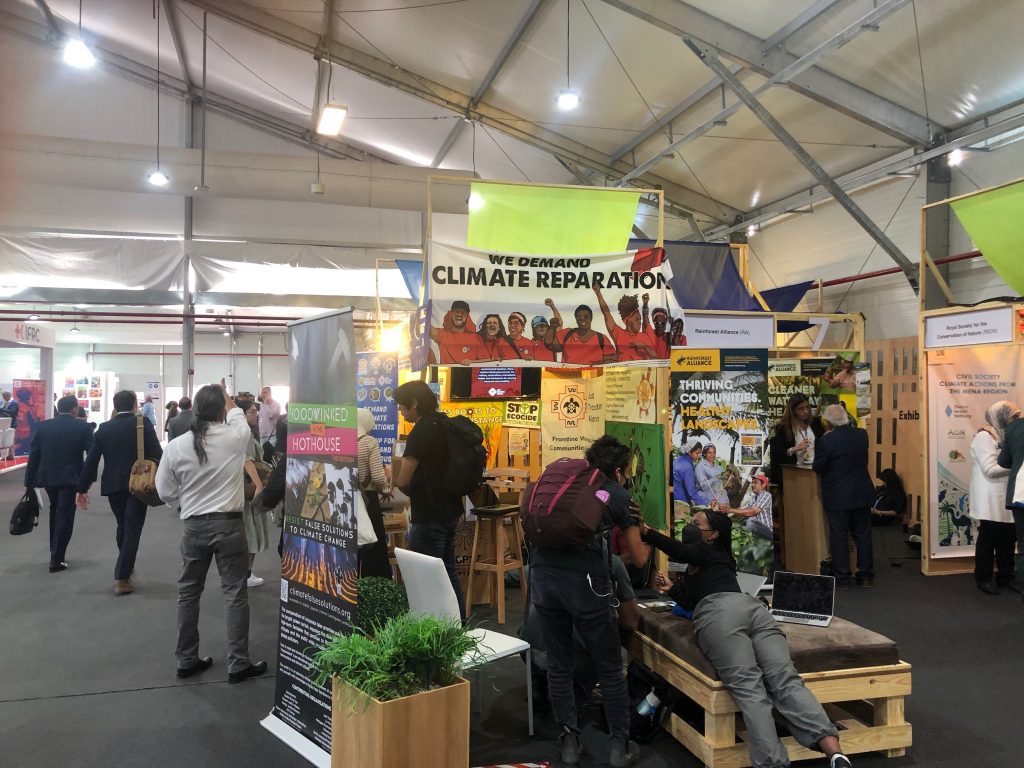
Photo credit: B. Cointe. CC-BY-NC-SA
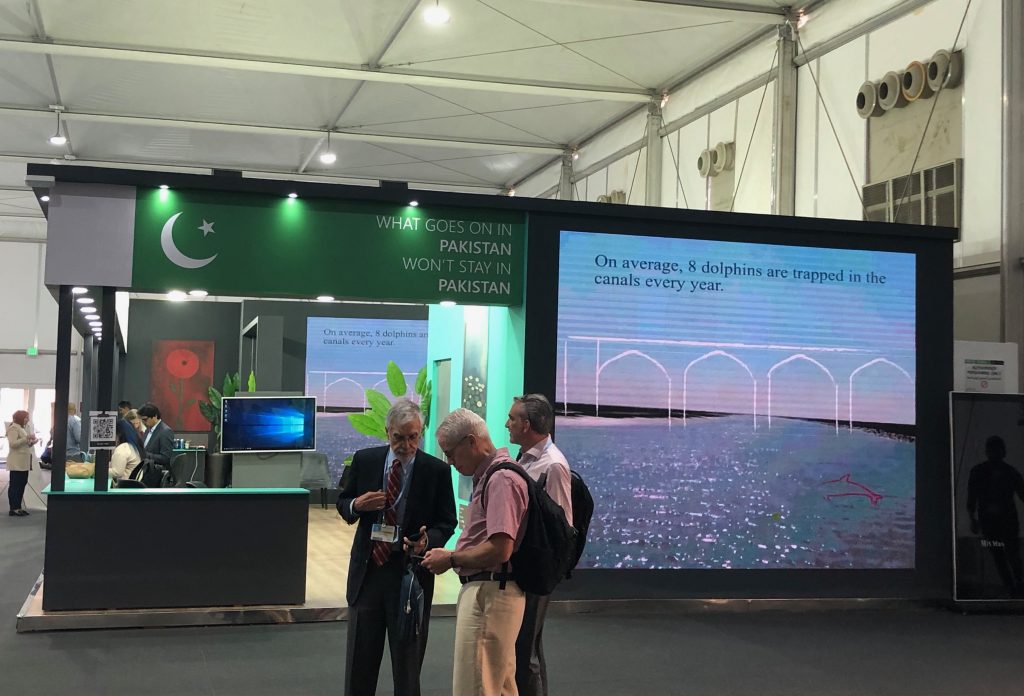
Photo credit: B. Cointe. CC-BY-NC-SA

Photo credit: B. Cointe. CC-BY-NC-SA
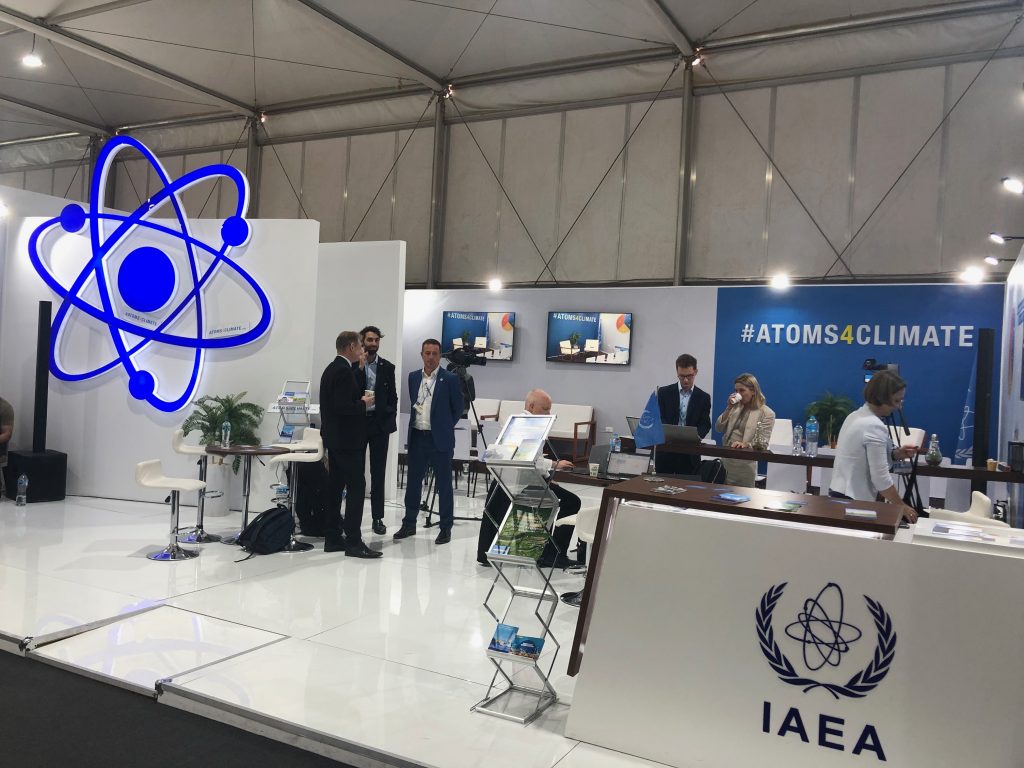
Photo credit: B. Cointe. CC-BY-NC-SA

Photo credit: B. Cointe. CC-BY-NC-SA
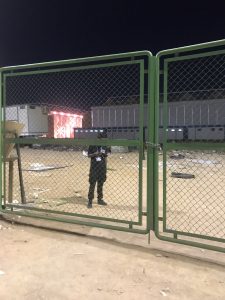
Photo credit: T. Schlesinger. CC-BY-NC-SA
Behind the Scenes

Little by little, the decor falls apart, as a reminder of the temporary nature of the installation. Trees are withering, lettering on the pavilion facades is falling off. Even the gliscening pavilion of the United Arab Emirates shows signs of wear: on the last days of the COP, signs politely ask not to touch the models illustrating the country’s greening efforts, blurring the message. The dihydrogen molecule proudly on display is no longer the promise of abundant of decarbonized fuel, but merely two polyester balls painted blue and glued together.
It now seems obvious that the people occupying the chairs in the pavilions are most likely tired observers looking for a place to sit. The exuberant decorations of some of the booths become less noticeable, and more noticeable are the miles of duct tape required to hold everything together. Clearly the sorting garbage cans, all labelled for different categories of waste (here glass/cardboard/other, there paper/cans/plastic) don’t sort much.
On the evening of the official closing of the COP, uncertainty and tension are at their highest on the negotiating side. Discussions take place mostly bilaterally and behind closed doors, in other words, behind the scenes. The pavilion hangars are empty, except for the workers who are already busy dismantling them. Packing up, until next year.
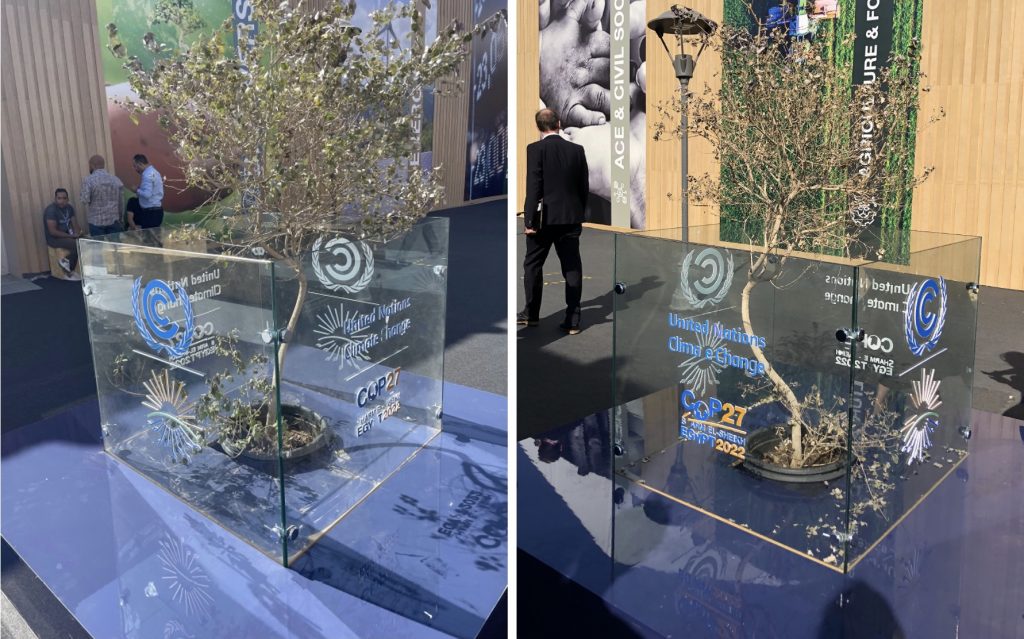
December 5, 2022.
Thanks to the students of the “COP-ENS” delegation: Elsa Bouly, Zoé Brioude, Naama Drahy, Rémy Giaccobo, Adrien Fauste-Gay, Alice Muñoz-Guypoui and Thibaud Schlesinger for sharing their observations and photos; and to Kewan Mertens for his proofreading and for finding the phrase “the COP or the Cup”.
[1] Stefan C. Aykut, Felix Schenuit, Jan Klenke, Emilie d’Amico; It’s a Performance, Not an Orchestra! Rethinking Soft Coordination in Global Climate Governance. Global Environmental Politics 2022; 22 (4): 173–196. doi: https://doi.org/10.1162/glep_a_00675
[2] United Nations Framework Convention on Climate Change.
[3] They are quieter but not quite: the noise of the air conditioning and the roar of the planes landing at the nearby airport interfered with the discussions. On occasion, delegates would stop mid-sentence to wait for a plane to pass.

